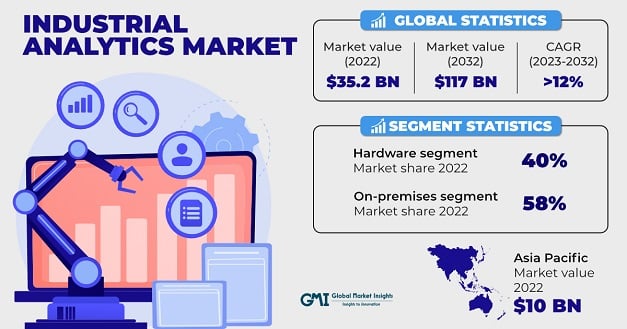Home > Media & Technology > Next Generation Technologies > Analytics and Business Intelligence > Industrial Analytics Market
Industrial Analytics Market Size
- Report ID: GMI7397
- Published Date: Nov 2023
- Report Format: PDF
Industrial Analytics Market Size
Industrial Analytics Market size was valued at USD 35.2 billion in 2022 and is anticipated to register a CAGR of over 12% between 2023 and 2032. Increasing investments in advanced analytics solutions are driving significant growth in the market. Businesses across various sectors are recognizing the value of data-driven insights in enhancing operational efficiency and decision-making. For instance, in March 2023, SAS, a leading analytics company, announced a strategic initiative to dedicate USD 1 billion in funding over the next three years for the advancement of cutting-edge analytics solutions. This investment aims to cater to the unique requirements of industries such as manufacturing, energy, government, banking, insurance, healthcare, and retail.
Industrial analytics solutions play a crucial role in monitoring and enhancing product quality for industries. By analyzing vast amounts of data from manufacturing processes, sensors & equipment, these solutions identify patterns and deviations. Real-time monitoring helps detect anomalies, ensuring timely intervention to prevent defects. Predictive analytics forecasts potential quality issues, enabling proactive measures. Through data-driven insights, industries can optimize production parameters, maintain consistent quality standards, minimize defects, and ultimately improve the overall product quality & customer satisfaction
| Report Attribute | Details |
|---|---|
| Base Year: | 2022 |
| Industrial Analytics Market Size in 2022: | USD 35.2 Billion |
| Forecast Period: | 2023 to 2032 |
| Forecast Period 2023 to 2032 CAGR: | 12% |
| 2032 Value Projection: | USD 117 Billion |
| Historical Data for: | 2018 - 2022 |
| No. of Pages: | 250 |
| Tables, Charts & Figures: | 433 |
| Segments covered: | Component, Analytics Type, Deployment Model, Enterprise Size, End Use |
| Growth Drivers: |
|
| Pitfalls & Challenges: |
|
Data quality and integration pose significant challenges in the industrial analytics market. Industrial data is often collected from diverse sources and in various formats, leading to inconsistencies & errors. Ensuring the accuracy, completeness, and reliability of this data is crucial for meaningful analysis. Additionally, integrating data from different systems, sensors, and devices within industrial environments is complex. Mismatched data formats and standards hinder seamless integration, making it challenging to derive cohesive insights and hindering the implementation of effective analytics solutions.

